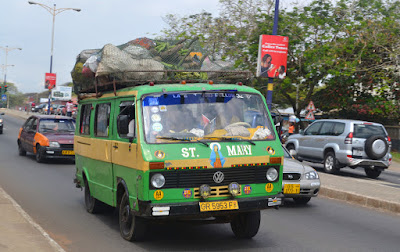THE STATE OF THE GHANAIAN INDIGENOUS TRANSPORT; AN ECONOMIC ISSUE OR INSTITUTIONAL FAILURE.
The state of Ghanaian indigenous transport.
An economic issue or institutional failure.
Ghana as a middle income country with a daily
minimum wage of GH¢ 9.68 and about 80% of its workforce in the informal sector,
not every working citizen can afford to buy a new car or used one. Even the
middle class have to go through the pain of “pulling a hair from their nostril " in
other to get a car of their own.
Due to this, most of the populace resort to public
transport. The government introduced the METRO
MASS TRANSIT (MMT) as an intervention to help the situation.
 |
| METRO MASS TRANSIT BUSES |
The most popular of shuttles in the country are
mostly mini buses popularly known as “TROTRO” which is the main source of
transportation for many Ghanaians. They transport people to work, school,
church, market, hauling of goods and food to the villages and city centers.
 |
| Mini buses popularly known as " TROTRO" |
Notwithstanding the great service these mini buses
are doing by conveying people to and fro, the state of these is nothing worth
talking about. This raises the question, is this an economic issue or
institutional failure?
On the issue of economics, it boils down to the maintenance
of these vehicles. The operators of the vehicles that is the drivers and the
owners as well need to spend money on maintaining them. They need to buy
genuine spare parts to keep these cars running. They need to do regular
servicing to keep the vehicles in good shape but the reality on the ground is
that most of these vehicles are out of shape and are not road worthy.
They mostly have dysfunctional brakes, lights, worn
out tires, torn seats, empty first aid kits etc. they have weak engines
producing thick exhaust gases which pollute our environment. Sometimes, you can
see the bare metals of the vehicle structure when board them which may tear
your attire and wound you as well.
Also most of these vehicles are over aged and have
been rejected in Europe and America which are then shipped here. Some of them
are over 30 years from the date of manufacture and are still on our roads.
On the other hand, what are the authorized
institutions doing to make sure that vehicles that are not roadworthy stay off our roads. Every vehicle on our roads goes for a road worthy test. The DRIVER AND VEHICLE LICENSING AUTHORITY
(DVLA) conducts a road worthy test for every vehicle on our roads yet 95%
of these minibuses are neither road worthy nor human friendly. So, by what standards
are these vehicles assessed?
Also, the MOTOR
TRAFFIC AND TRANSPORT UNIT (MTTU) of the GHANA POLICE SERVICE does random checks. They assess these vehicles
on whether they are in good condition or not but still these death traps are on
our roads. So one wonders where the gaps are. These vehicles do not even have a
functioning fire extinguisher.
 |
| MOTOR TRAFFIC AND TRANSPORT UNIT OF THE GHANA POLICE UNDERTAKING A ROAD CHECK |
The MINISTRY OF TRANSPORT, GHANA PRIVATE ROAD AND TRANSPORT UNION (GPRTU) and the GHANA STANDARDS AUTHORITY are supposed to regulate the kind of vehicles that are imported into the country. Most of these vehicles are the ones rejected due to emission regulations and others factors elsewhere yet they find their way into the country because there is no proper regulation, legislature and enforcement to that respect.
So now, the question is, is it an economic issue
that these vehicles are not maintained well or a failure on the part of the
responsible authorities to do their work?
Ghana must sit up.




Comments
Post a Comment